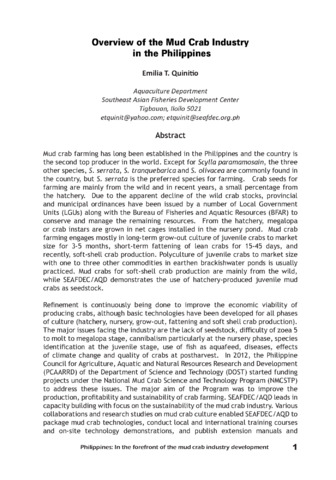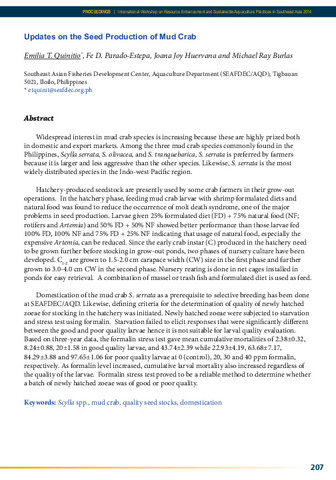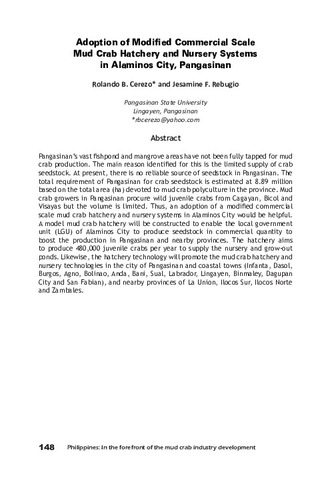| dc.contributor.author | Parado-Estepa, Fe D. | |
| dc.contributor.author | Alava, Veronica | |
| dc.contributor.author | Garibay, Esteban | |
| dc.contributor.author | Bejemino, Churchill | |
| dc.contributor.author | Sumile, Jony | |
| dc.contributor.author | Silvestre, Jenalyn | |
| dc.contributor.author | Quinitio, Emilia T. | |
| dc.contributor.editor | Quinitio, Emilia T. | |
| dc.contributor.editor | Parado-Estepa, Fe Dolores | |
| dc.contributor.editor | Coloso, Relicardo M. | |
| dc.date.accessioned | 2017-08-25T08:53:26Z | |
| dc.date.accessioned | 2017-08-25T16:28:21Z | |
| dc.date.available | 2017-08-25T08:53:26Z | |
| dc.date.available | 2017-08-25T16:28:21Z | |
| dc.date.issued | 2017 | |
| dc.identifier.citation | Parado-Estepa, F. D., Alava, V. R., Garibay, E., Bejemino, C., Sumile, J., Silvestre, J., & Quinitio, E. T. (2017). Recent developments and enhancing transfer of the nursery technology for the mud crab Scylla serrata. In E. T. Quinitio, F. D. Parado-Estepa, & R. M. Coloso (Eds.), Philippines : In the forefront of the mud crab industry development : proceedings of the 1st National Mud Crab Congress, 16-18 November 2015, Iloilo City, Philippines (pp. 13-21). Tigbauan, Iloilo, Philippines: Aquaculture Department, Southeast Asian Fisheries Development Center. | en |
| dc.identifier.isbn | 9789719931072 | |
| dc.identifier.uri | http://hdl.handle.net/10862/3170 | |
| dc.description.abstract | The development of hatchery techniques for seed production of mud crab is expected to address the present problem on the depletion of wild seedstock supply for stocking in grow-out ponds. The nursery serves as the link between the two phases of culture as this involves growing of juvenile crabs produced in the hatchery to sizes that are suitable for stocking in the ponds.
Nursery rearing involves the use of net cages installed in ponds as holding system for ease in harvest and retrieval of crabs. In the first nursery phase, 0.3-0.5 cm carapace width (CW) juvenile crabs are reared to 1.5-2.0 cm CW for 3-4 weeks and stocks are harvested for selling or are grown further in a second nursery phase in which crabs reach 2.5-3.0 cm after another 3-4 weeks. This paper includes a review of techniques initially developed for the nursery and more recent refinements which involve the use of higher crab instar densities, provision of suitable shelters, trimming of claws and sorting. In addition, production results in farms of collaborators are presented to highlight the efficiency of dissemination and also discusses the challenges faced by the potential nursery industry. | en |
| dc.language.iso | en | en |
| dc.publisher | Aquaculture Department, Southeast Asian Fisheries Development Center | en |
| dc.subject | Scylla serrata | |
| dc.subject | Philippines | en |
| dc.subject | hatcheries | en |
| dc.title | Recent developments and enhancing transfer of the nursery technology for the mud crab Scylla serrata | en |
| dc.type | Conference paper | en |
| dc.citation.spage | 13 | |
| dc.citation.epage | 21 | |
| dc.subject.asfa | aquaculture | en |
| dc.subject.asfa | cage culture | en |
| dc.subject.asfa | crab culture | en |
| dc.subject.asfa | harvesting | en |
| dc.subject.asfa | instars | en |
| dc.subject.asfa | juveniles | en |
| dc.subject.asfa | Larval development | en |
| dc.subject.asfa | marine crustaceans | en |
| dc.subject.asfa | rearing techniques | en |
| dc.subject.asfa | seed (aquaculture) | en |
| dc.subject.asfa | seeding (aquaculture) | en |
| dc.subject.asfa | seed production | en |
| dc.subject.asfa | stocking (organisms) | en |
| dc.citation.conferenceTitle | Philippines : In the forefront of the mud crab industry development : proceedings of the 1st National Mud Crab Congress, 16-18 November 2015, Iloilo City, Philippines | en |
| dc.subject.scientificName | Scylla serrata | |



